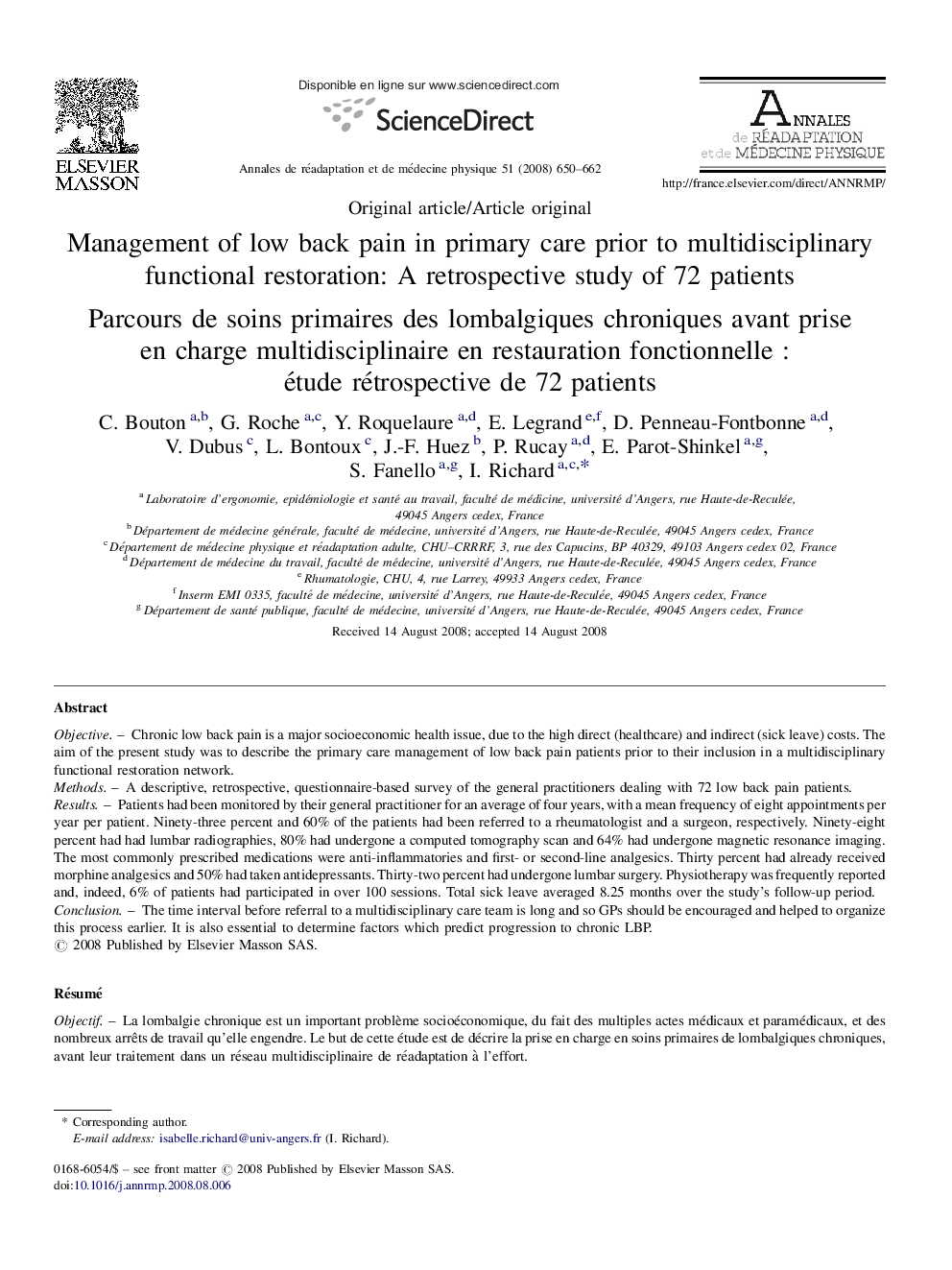| کد مقاله | کد نشریه | سال انتشار | مقاله انگلیسی | نسخه تمام متن |
|---|---|---|---|---|
| 4040073 | 1264284 | 2008 | 13 صفحه PDF | دانلود رایگان |

ObjectiveChronic low back pain is a major socioeconomic health issue, due to the high direct (healthcare) and indirect (sick leave) costs. The aim of the present study was to describe the primary care management of low back pain patients prior to their inclusion in a multidisciplinary functional restoration network.MethodsA descriptive, retrospective, questionnaire-based survey of the general practitioners dealing with 72 low back pain patients.ResultsPatients had been monitored by their general practitioner for an average of four years, with a mean frequency of eight appointments per year per patient. Ninety-three percent and 60% of the patients had been referred to a rheumatologist and a surgeon, respectively. Ninety-eight percent had had lumbar radiographies, 80% had undergone a computed tomography scan and 64% had undergone magnetic resonance imaging. The most commonly prescribed medications were anti-inflammatories and first- or second-line analgesics. Thirty percent had already received morphine analgesics and 50% had taken antidepressants. Thirty-two percent had undergone lumbar surgery. Physiotherapy was frequently reported and, indeed, 6% of patients had participated in over 100 sessions. Total sick leave averaged 8.25 months over the study’s follow-up period.ConclusionThe time interval before referral to a multidisciplinary care team is long and so GPs should be encouraged and helped to organize this process earlier. It is also essential to determine factors which predict progression to chronic LBP.
RésuméObjectifLa lombalgie chronique est un important problème socioéconomique, du fait des multiples actes médicaux et paramédicaux, et des nombreux arrêts de travail qu’elle engendre. Le but de cette étude est de décrire la prise en charge en soins primaires de lombalgiques chroniques, avant leur traitement dans un réseau multidisciplinaire de réadaptation à l’effort.MéthodesÉtude descriptive et rétrospective, réalisée par questionnaire auprès des généralistes de 72 patients traités dans le réseau régional.RésultatsLes patients étaient suivis pour lombalgie depuis en moyenne quatre ans par leur généraliste, avec une fréquence de huit consultations spécifiques par an par patient. Quatre-vingt-treize pour cent des patients avaient vu un rhumatologue et 60 % un chirurgien. Quatre-vingt-dix-huit pour cent des patients ont bénéficié de radiographies lombaires, 80 % d’un scanner et 64 % d’une IRM. Les traitements médicamenteux comportaient préférentiellement des antalgiques de palier 1 ou 2 et des anti-inflammatoires stéroïdiens ou non. Trente pour cent avaient déjà reçu des morphiniques et 50 % des antidépresseurs. Un antécédent de chirurgie lombaire était retrouvé chez un tiers des patients. La kinésithérapie était fréquemment prescrite, avec 6 % des patients ayant eu plus de 100 séances. La durée d’arrêt de travail était en moyenne de 8,25 mois.ConclusionsL’orientation vers un réseau spécialisé est tardive, il paraît important d’aider les généralistes à organiser un recours multidisciplinaire plus précoce pour les lombalgiques chroniques. La recherche des facteurs permettant de prédire, dès la phase précoce de la lombalgie, les patients à risque de chronicisation est également indispensable.
Journal: Annales de Réadaptation et de Médecine Physique - Volume 51, Issue 8, November 2008, Pages 650–662